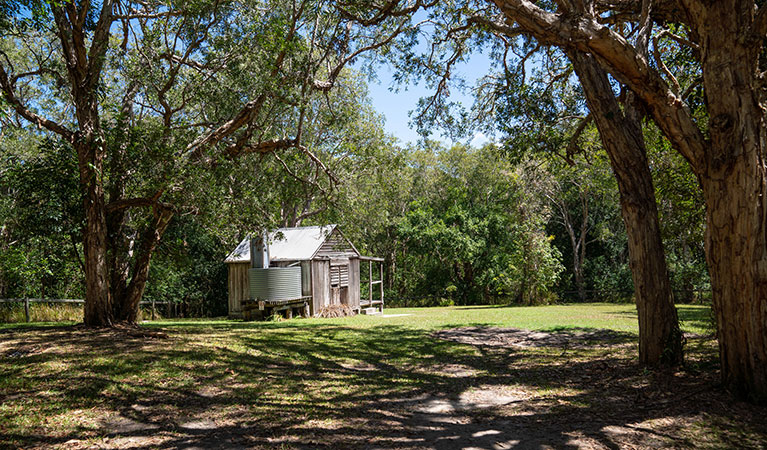Kylies Hut
Crowdy Bay National Park
Overview
Visit Kylies Hut along Metcalfes walking track in Crowdy Bay National Park, near Port Macquarie. The historic hut was used as a writer’s retreat by award-winning Australian novelist Kylie Tennant.
- Type
- Historic buildings/places
- Where
- Crowdy Bay National Park in North Coast
- Accessibility
- No wheelchair access
- Entry fees
- Park entry fees apply
- What to
bring - Drinking water, hat, sunscreen, sturdy shoes, suitable clothing
- Please note
- Kylies Hut burnt down in the 2019–2020 bushfires and only the foundations remain. The hut will be rebuilt in 2021.
- Eastern grey kangaroos live in this area of the park. They’re powerful animals, so please appreciate them from a distance.
While enjoying a day trip or overnight stay in Crowdy Bay National Park, Kylies Hut is well worth a visit. Set in a shady glen surrounded by coastal forest, you’ll pass paperbarks and sheoaks along Metcalfes walking track on your way to the hut.
Local farmer Ernie Metcalfe built the rustic hut for the novelist and journalist Kylie Tennant in the late 1960s. With a single room, verandah and stone fireplace, its appearance harked back to a time when Crowdy Bay was wild coastal heathland and swamp. It was during Kylie’s time here that she wrote The Man on the Headland, a novel influenced by her years spent living in the natural beauty of Crowdy Bay.
Sadly, the original hut was destroyed in the 2019-20 bushfires that burned through much of the area. It’s being reconstructed to preserve this important piece of history.
After you’ve explored the hut and surrounds, there’s plenty to see and do nearby. Picnic in the shade of the paperbarks or take a dip at Kylies Beach.
Nearby
-

Metcalfes walking track
Get up close with nature on Metcalfes walking track, which links Indian Head and Kylies Beach in Crowdy Bay National Park. It's a family friendly hike and the kids might even spot a koala.
-

Indian Head campground
Indian Head campground near Port Macquarie is great place to set up your campsite. There are plenty of walking opportunities, resident kangaroos and the beach is nearby.
-

Kylies Beach campground
Kylies Beach campground in Crowdy Bay National Park on the north coast offers quiet beachside campsites for caravans, trailers and tents.
-

Diamond Head campground
The beachside campground at Diamond Head is one of the most popular places to stay in Crowdy Bay National Park. It has caravan sites, additional walk-in campsites and picnic amenities.
Map
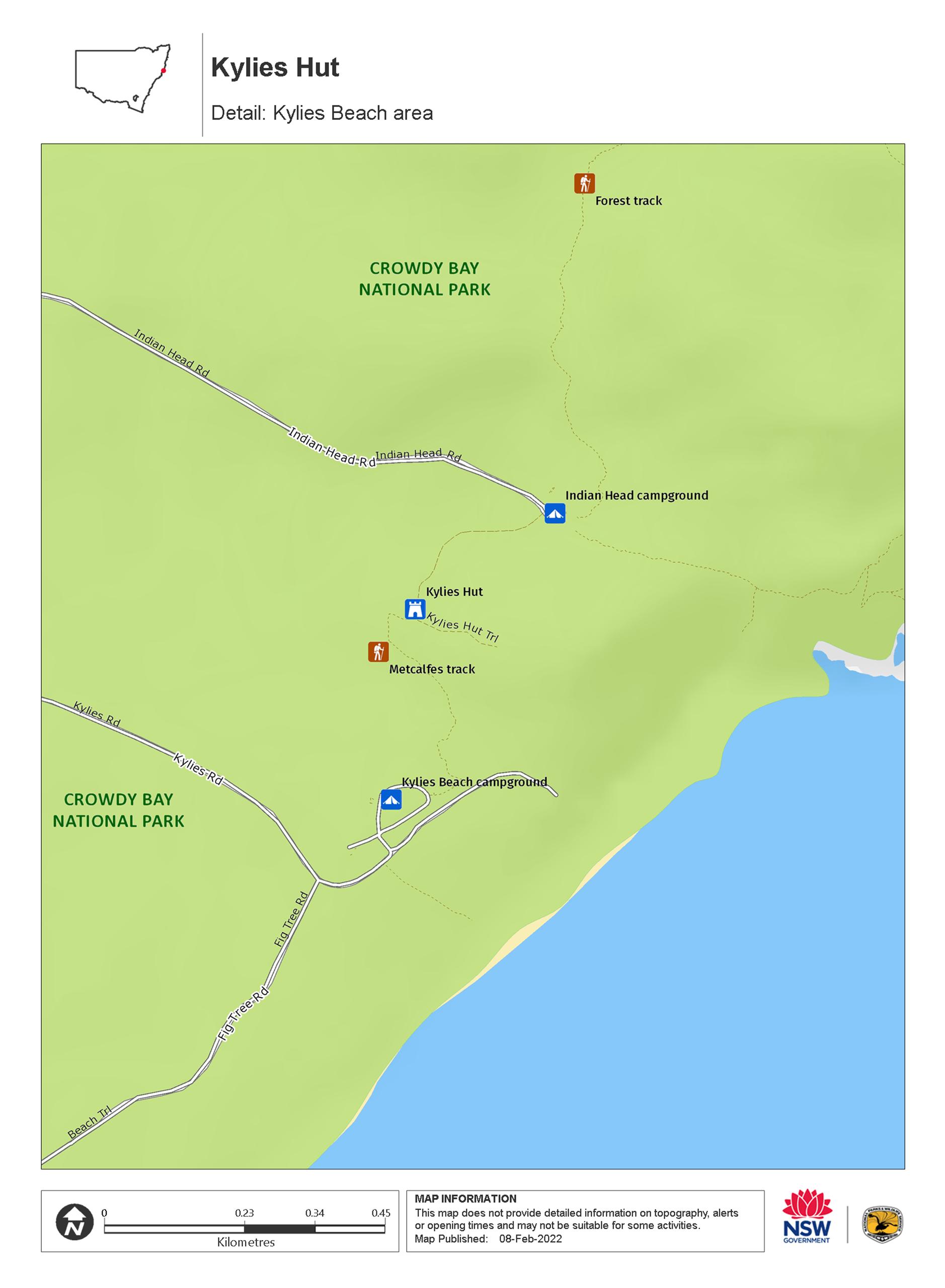
Map legend

Local alerts
For the latest updates on fires, closures and other alerts in this area, see https://www.nationalparks.nsw.gov.au/things-to-do/historic-buildings-places/kylies-hut/local-alerts
General enquiries
- National Parks Contact Centre
- 7am to 7pm daily
- 1300 072 757 (13000 PARKS) for the cost of a local call within Australia excluding mobiles
- parks.info@environment.nsw.gov.au
Park info
- in Crowdy Bay National Park in the North Coast region
Crowdy Bay National Park is always open but may have to close at times due to poor weather or fire danger.
-
Park entry fees:
$8 per vehicle per day.
Buy annual pass.
Visitor info
All the practical information you need to know about Kylies Hut.
Getting there and parking
You can reach Kylies Hut from Indian Head campground or Kylies Beach carpark.
From Indian Head campground:
- Follow the road on your right as you drive into Indian Head campground until you reach a gate
- Kylies Hut is a short 150m walk beyond the gate
From Kylies Beach carpark:
- Follow Kylies Beach Road past Kylies Beach campground to the carpark
- Metcalfes walking track is on your left as you drive into the carpark. Kylies Hut is a 550m walk from here.
Road quality
- Unsealed roads
Vehicle access
- 2WD vehicles
Weather restrictions
- All weather
Parking
There is parking at Indian Head campground and Kylies Beach carpark, where Metcalfes walking track to Kylies Hut begins.
Facilities
- The nearest non-flush toilets are at Indian Head campground, 150m walk from Kylies Hut.
- The nearest carparks are at Indian Head campground (150m) and Kylies Beach (550m).
Maps and downloads
Accessibility
Disability access level - no wheelchair access
Permitted
Cycling
Mountain biking is permitted on public roads and some management trails.
Prohibited
Camp fires and solid fuel burners
Camping
Gathering firewood
Horses
Pets
Pets and domestic animals (other than certified assistance animals) are not permitted. Find out which regional parks allow dog walking and see the pets in parks policy for more information.
Smoking
NSW national parks are no smoking areas.
Learn more
Kylies Hut is in Crowdy Bay National Park. Here are just some of the reasons why this park is special:
Gifts of nature
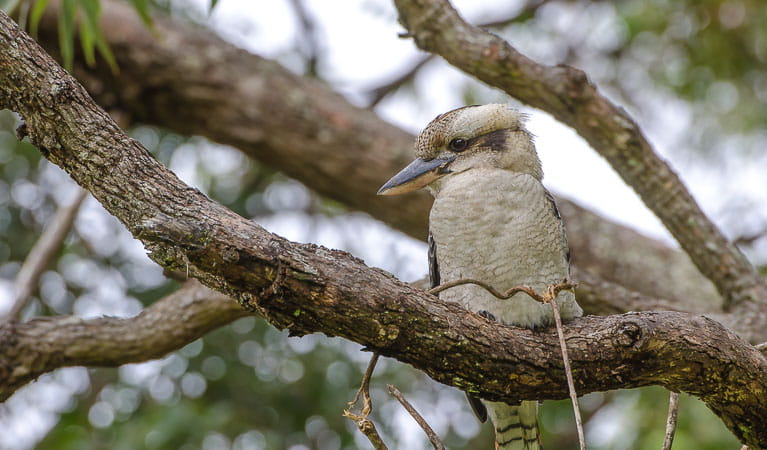
The views may grab the headlines, but within the park are more secretive delights that change with the seasons. These include rolling dunes that spring to life with wildflowers and migratory birds that populate the lagoons. There are lots of great lookouts to spot whales from as they migrate along the coast in winter or watch ospreys and falcons circle in the skies. Not to mention, kangaroos, koalas and cockatoos galore. Christmas visitors will receive an extra gift, Crowdy Bay's famous festive season blooms of Christmas bells.
- Mermaid lookout track Mermaid lookout track takes you on a tour of Crowdy Bay National Park's secret surprises. Secluded coves, sweeping beaches and mountain views await you on this short hike.
- Metcalfes walking track Get up close with nature on Metcalfes walking track, which links Indian Head and Kylies Beach in Crowdy Bay National Park. It's a family friendly hike and the kids might even spot a koala.
Past present
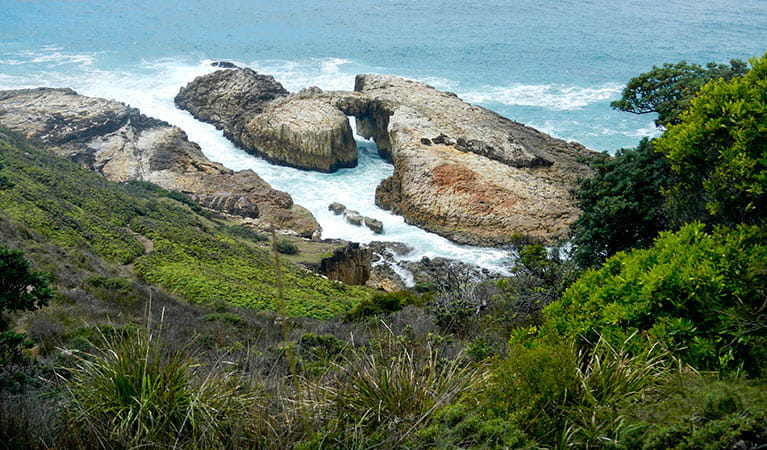
The Birpai People have climbed the headlands, swum in the rivers, crossed the sand dunes and walked the beaches of Crowdy Bay National Park for thousands of years. The sea and forest areas were a rich food source for the Birpai People, providing fish, shellfish, wallabies and berries. The park protects a number of Aboriginal sites, like shell middens and campsites, the oldest of which are about 6,000 years old. The park continues to be an important place for local Aboriginal people today.
Postcard perfect
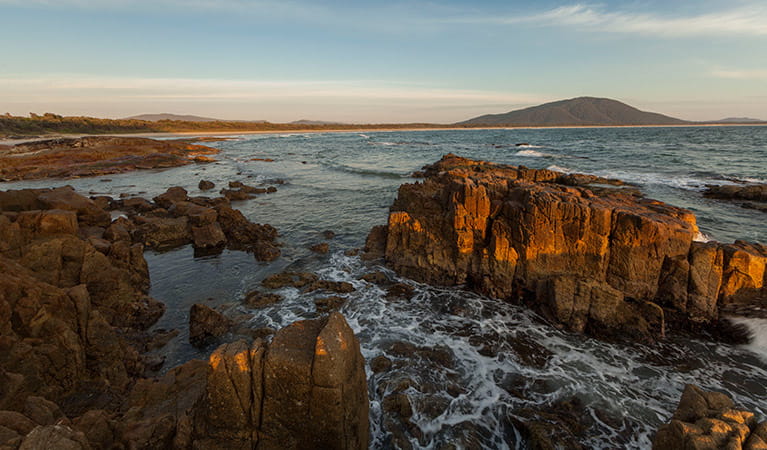
This spectacular environment is truly something to write home about. If you can't find the words, try these - panoramic, breathtaking, even gobsmacking. Then again, you'll probably be too busy exploring the tracks, gazing agape at the huge rock arches, communing with wildlife or throwing a line to write lines on a postcard.
- Crowdy Gap walking track The short and sweet Crowdy Gap walking track in Crowdy Bay National Park, near Taree, offers a stroll through rainforest with scenic views and the chance to see koalas.
- Diamond Head Loop walk Diamond Head loop walk offers scenic coastal views across Crowdy Bay National Park. Expect beaches, lookouts, and glinting rock faces, giving Diamond Head its name.
Writers' retreat
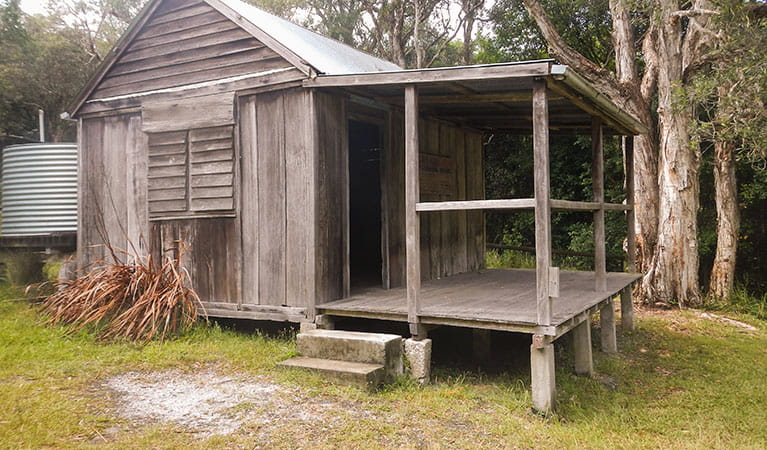
During World War II, the Australian author Kylie Tennant moved to Laurieton where she met the reclusive Ernie Metcalfe, a farmer who grazed cattle on Diamond Head. Ernie built Kylie a timber slab hut to use as a writer's retreat. In return, Kylie portrayed Metcalfe and Crowdy Bay in the book The Man on the Headland. Kylie Tennant donated the hut and the surrounding land to Crowdy Bay National Park in 1976. If you're walking along Metcalfe walking track, stop to have a look inside Kylie's hut.
- Kylies Hut Visit Kylies Hut along Metcalfes walking track in Crowdy Bay National Park, near Port Macquarie. The historic hut was used as a writer’s retreat by award-winning Australian novelist Kylie Tennant.
Plants and animals protected in this park
Animals
-

White-bellied sea eagle (Haliaeetus leucogaster)
White-bellied sea eagles can be easily identified by their white tail and dark grey wings. These raptors are often spotted cruising the coastal breezes throughout Australia, and make for some scenic bird watching. Powerful Australian birds of prey, they are known to mate for life, and return each year to the same nest to breed.
-
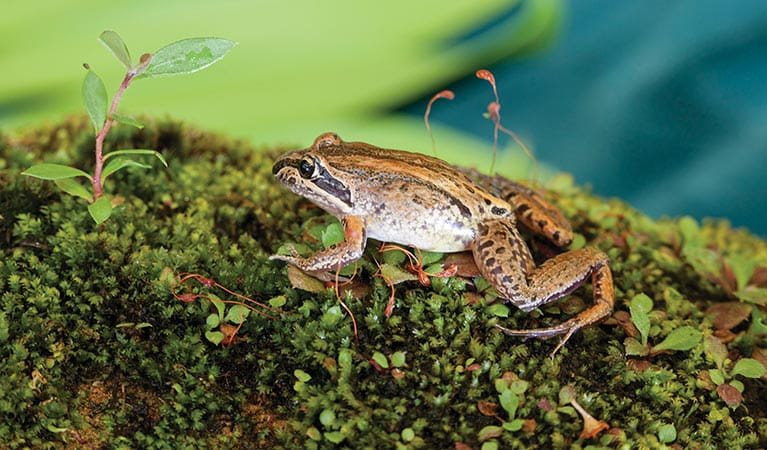
Brown-striped frog (Lymnastes peronii)
One of the most common frogs found in Australia, the ground-dwelling brown-striped frog lives in ponds, dams and swamps along the east coast. Also known as the striped marsh frog, this amphibian grows to 6.5cm across and has a distinctive ‘tok’ call that can be heard all year round.
-
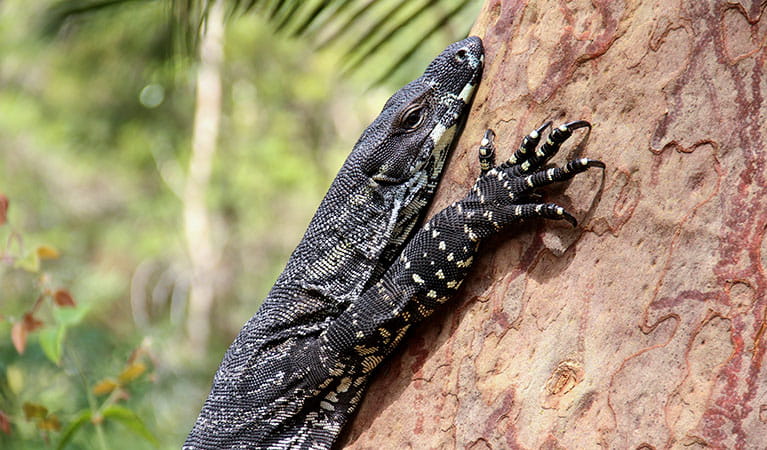
Lace monitor (Varanus varius)
One of Australia’s largest lizards, the carnivorous tree-dwelling lace monitor, or tree goanna, can grow to 2m in length and is found in forests and coastal tablelands across eastern Australia. These Australian animals are typically dark blue in colour with whitish spots or blotches.
Plants
-
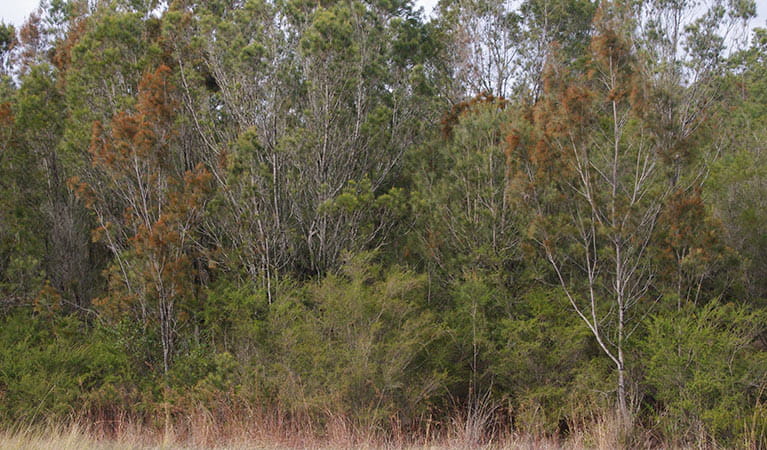
Black sheoak (Allocasuarina littoralis)
The black sheoak is one of a number of casuarina species found across the east coast of Australia and nearby tablelands. Growing to a height of 5-15m, these hardy Australian native plants can survive in poor or sandy soils. The barrel-shaped cone of the black sheoak grows to 10-30mm long.
-

Grass tree (Xanthorrea spp.)
An iconic part of the Australian landscape, the grass tree is widespread across eastern NSW. These Australian native plants have a thick fire-blackened trunk and long spiked leaves. They are found in heath and open forests across eastern NSW. The grass tree grows 1-5m in height and produces striking white-flowered spikes which grow up to 1m long.

